In a cross between a black and a white guinea pig, all members of the F₁ generation are black. The F₂ generation is made up of approximately 3/4 black and 1/4 white guinea pigs. What will the offspring be like if two F₂ white guinea pigs are mated?
Table of contents
- 1. Introduction to Genetics51m
- 2. Mendel's Laws of Inheritance3h 37m
- 3. Extensions to Mendelian Inheritance2h 41m
- 4. Genetic Mapping and Linkage2h 28m
- 5. Genetics of Bacteria and Viruses1h 21m
- 6. Chromosomal Variation1h 48m
- 7. DNA and Chromosome Structure56m
- 8. DNA Replication1h 10m
- 9. Mitosis and Meiosis1h 34m
- 10. Transcription1h 0m
- 11. Translation58m
- 12. Gene Regulation in Prokaryotes1h 19m
- 13. Gene Regulation in Eukaryotes44m
- 14. Genetic Control of Development44m
- 15. Genomes and Genomics1h 50m
- 16. Transposable Elements47m
- 17. Mutation, Repair, and Recombination1h 6m
- 18. Molecular Genetic Tools19m
- 19. Cancer Genetics29m
- 20. Quantitative Genetics1h 26m
- 21. Population Genetics50m
- 22. Evolutionary Genetics29m
2. Mendel's Laws of Inheritance
Monohybrid Cross
Problem 10b
Textbook Question
The dorsal pigment pattern of frogs can be either 'leopard' (white pigment between dark spots) or 'mottled' (pigment between spots appears mottled). The trait is controlled by an autosomal gene. Males and females are selected from pure-breeding populations, and a pair of reciprocal crosses is performed. The cross results are shown below.
Cross 1: P₁: Male leopard x male mottled
F₁: All mottled
F₂: 70 mottled, 22 leopard
Cross 2: P₁: Male mottled x female leopard
F₁: All mottled
F₂: 50 mottled, 18 leopard
Compare and contrast the results of the reciprocal crosses in the context of autosomal gene inheritance.
 Verified step by step guidance
Verified step by step guidance1
Step 1: Begin by understanding the concept of autosomal gene inheritance. Autosomal genes are located on non-sex chromosomes, meaning they are inherited equally by males and females. Traits controlled by autosomal genes are not influenced by the sex of the parent.
Step 2: Analyze the results of Cross 1. In the P₁ generation, a male leopard is crossed with a male mottled. The F₁ generation shows all mottled offspring, indicating that the mottled trait is dominant over the leopard trait. In the F₂ generation, the ratio of mottled to leopard offspring is approximately 3:1, which is consistent with Mendelian inheritance for a single autosomal gene with complete dominance.
Step 3: Examine the results of Cross 2. In the P₁ generation, a male mottled is crossed with a female leopard. The F₁ generation again shows all mottled offspring, confirming that the mottled trait is dominant. In the F₂ generation, the ratio of mottled to leopard offspring is again approximately 3:1, consistent with autosomal inheritance.
Step 4: Compare the results of the reciprocal crosses. Both crosses yield identical patterns of inheritance, with all F₁ offspring being mottled and the F₂ generation showing a 3:1 ratio of mottled to leopard. This indicates that the inheritance of the trait is autosomal and not influenced by the sex of the parent.
Step 5: Conclude that the results of the reciprocal crosses support the hypothesis that the dorsal pigment pattern in frogs is controlled by a single autosomal gene with the mottled trait being dominant over the leopard trait. The identical outcomes in both crosses confirm that the gene is autosomal and not sex-linked.
 Verified video answer for a similar problem:
Verified video answer for a similar problem:This video solution was recommended by our tutors as helpful for the problem above
Video duration:
2mPlay a video:
Was this helpful?
Key Concepts
Here are the essential concepts you must grasp in order to answer the question correctly.
Autosomal Inheritance
Autosomal inheritance refers to the transmission of genes located on the autosomes, which are the non-sex chromosomes. Traits controlled by autosomal genes can be dominant or recessive. In this case, the dorsal pigment pattern in frogs is influenced by an autosomal gene, where the mottled phenotype appears to be dominant over the leopard phenotype, as indicated by the F₁ generation showing all mottled offspring.
Recommended video:
Guided course

Autosomal Pedigrees
Reciprocal Crosses
Reciprocal crosses involve mating individuals of different phenotypes to observe the inheritance patterns of traits. In this scenario, two reciprocal crosses were performed between leopard and mottled frogs. The results from both crosses show that the F₁ generation is consistently mottled, suggesting that the trait's dominance is not influenced by the sex of the parent, which is a key aspect of understanding autosomal inheritance.
Recommended video:
Guided course

Trihybrid Cross
Phenotypic Ratios
Phenotypic ratios represent the relative frequencies of different phenotypes in the offspring resulting from genetic crosses. In the F₂ generations of both crosses, the observed ratios of mottled to leopard frogs (70:22 and 50:18) suggest a consistent pattern of inheritance. These ratios can be analyzed to infer the underlying genetic mechanisms, such as the dominance of the mottled trait over the leopard trait in this autosomal inheritance scenario.
Recommended video:
Guided course

Mutations and Phenotypes
Related Videos
Related Practice
Textbook Question
523
views


